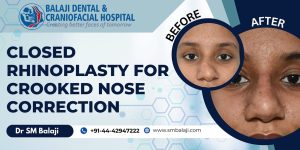Patient with a history of a childhood jaw injury
The patient is a now 13-year-old boy from Gudur in Telangana, India who had fallen down on his chin as a child. His parents had noticed the development of a facial asymmetry in their son ever since the fall. This fall had been followed by a period of pain and difficulty opening his mouth. However the TMJ pain and TMJ symptoms gradually improved with time resulting in the parents neglecting to seek medical attention for this fall. The facial asymmetry has been gradually worsening and it had now become esthetically unappealing. The parents decided to seek medical help as this was leading to a lot of bullying at school.
It is very important for parents to note that complicated surgical management of TMJ ankylosis can be avoided if optimal medical treatment is given at the time of the initial injury to the TMJ. Whenever a child falls on his chin and complains of even minor pain in the jaw joint, it would be prudent to take the child to the hospital for a checkup. Treatment initiated at this time will help avoid the development of complications later.
Parents approach a local oral surgeon for correction of the facial asymmetry
They had approached a local oral surgeon when he was around 4 years old for correction of the deformity. He had examined the patient and explained to the parents that the patient had ankylosis of the right temporomandibular joint. The oral surgeon had further advised the patient’s parents that he needed to get this addressed at a specialty temporomandibular joint surgery hospital for optimal surgical management. He had thus referred them to Balaji Dental and Craniofacial Hospital for further management.
A gap arthroplasty surgery using a temporalis muscle flap interpositioning had been performed by Dr SM Balaji with complete resolution of the patient’s ankylosis. The patient had been advised to return at a later date for condylar reconstruction surgery using costochondral rib graft. This would enable growth of the patient’s condyle. The patient now returns to our hospital for this surgery.
Injury to the TMJ always leads to growth discrepancies that affect the mandibular condyle and mandibular body. When growth of the mandible is affected, mandibular distraction osteogenesis is performed to set right the discrepancy and reestablish normal facial form and symmetry. When the ankylosis is bilateral, it can result in extreme micrognathia leading to even partial airway obstruction.
Internal devices are always preferred over external devices because of patient convenience. A consolidation phase is always given after fixation of distraction devices to ensure stabilization of bone structure following surgery. This falls under the purview of oral and maxillofacial surgery. Distraction is initiated after completion of the latency period.
Patient presents for initial consultation and treatment planning at our hospital
Dr.SM Balaji, distraction osteogenesis surgery specialist, examined the patient and ordered radiological studies. He explained to them that the child needed to undergo ramus distraction osteogenesis for correction of the facial asymmetry following the condylar reconstruction surgery. This would help induce growth of the right condyle. Therefore, a costochondral rib graft would need to be harvested to create a condyle and to reinforce the mandibular ramus. This would create a primary growth center to induce the growth of the mandible. There was also the presence of a hyperplastic right coronoid process.
Surgical reconstruction of the condyle and ramus
Under general anesthesia, a right inframammary incision was made and a costochondral rib graft harvested. A Valsalva maneuver was next performed to ensure that there was no perforation into the thoracic cavity following which closure was done in layers. This was followed by a right submandibular incision through which dissection was done up to the condyle. The hyperplastic coronoid was reduced and a coronoidectomy was done. The condyle was reconstructed using the rib graft and fixed using titanium screws. The ramus of the mandible was also augmented with a rib graft. Closure was then done using resorbable sutures.
Successful outcome of the surgical procedure
The surgery was a complete success. The condyle was successfully created and ramus augmented. Postoperative OPG taken 2 months after the surgery revealed sufficient bone consolidation. The patient also showed a more symmetrical face following grafting. Distraction osteogenesis to obtain complete facial symmetry will be performed after a period of about 6 months.





